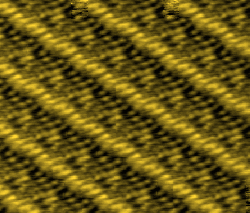Building a Crystal Bridge

At warm temperatures liquid crystals normally “melt,” but under the right conditions, a filament can crystallize above the melting point. The first observation of this effect is reported in the 25 June PRL. The researchers showed that a drop of warm liquid between two glass surfaces can spontaneously form a liquid crystal “bridge” when the surfaces get close enough. They used an atomic force microscope (AFM) to measure the force the bridge generates. Their findings confirm theories on the behavior of liquid crystals and may allow such bridges to be used in a variety of applications, including self-arranging crystals for use in optics.
When a fluid of the right cigar-shaped molecules is cooled below a “critical” temperature, the molecules align to create a liquid crystal–a liquid in which the molecules remain oriented. Over twenty years ago, theorists predicted that, if two plates were coated with a layer of liquid crystal molecules perpendicular to their surfaces, these molecules would align other molecules and enforce order across a narrow gap, even above the critical temperature. But experimentalists had difficulty detecting such a bridge because it could only occur over a small range of temperatures and distances.
A team in Slovenia at the J. Stefan Institute and Ljubljana University now reports the detection of liquid crystal bridges between a glass microsphere and a glass plate. They treated both surfaces with a chemical that creates one layer of molecules standing on end. They then placed a drop of liquid between the two surfaces and used an AFM to inch the microsphere to within a few nanometers of the plate. When a bridge formed, it tugged the two surfaces together, and the researchers measured that pull with the AFM. They found that the tugs occurred at a range of temperatures and distances in “good agreement” with the decades-old theory, according to Igor Musevic, a team member from the University of Ljubljana.
David Alleneder of Kent State University in Ohio credits the team’s success to their novel use of AFM technology to detect the bridges. “A lot of the other techniques people were using just weren’t sensitive enough,” he says. Musevic and his colleagues believe that crystal bridges might someday connect microscopic beads in a lattice structure that would reflect or transmit certain wavelengths of light–a so-called photonic crystal. Such a structure could be used in optics, but this is only one idea. “I think this work will trigger other people to find applications,” he says.
–Geoff Brumfiel


